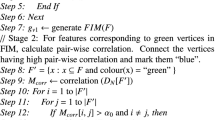Abstract
In many data analysis tasks, one is often confronted with the problem of selecting features from very high dimensional data. The feature selection problem is essentially a combinatorial optimization problem which is computationally expensive. To overcome this problem it is frequently assumed that either features independently influence the class variable or do so only involving pairwise feature interaction. To overcome this problem, we draw on recent work on hyper-graph clustering to extract maximally coherent feature groups from a set of objects using high-order (rather than pairwise) similarities. We propose a three step algorithm that, namely, i) first constructs a graph in which each node corresponds to each feature, and each edge has a weight corresponding to the interaction information among features connected by that edge, ii) perform hypergraph clustering to select a highly coherent set of features, iii) further selects features based on a new measure called the multidimensional interaction information (MII). The advantage of MII is that it incorporates third or higher order feature interactions. This is realized using hypergraph clustering, which separates features into clusters prior to selection, thereby allowing us to limit the search space for higher order interactions. Experimental results demonstrate the effectiveness of our feature selection method on a number of standard data-sets.
Access this chapter
Tax calculation will be finalised at checkout
Purchases are for personal use only
Preview
Unable to display preview. Download preview PDF.
Similar content being viewed by others
References
Balagani, S., Phoha, V.: On the Feature Selection Criterion Based on an Approximation of Multidimensional Mutual Information. IEEE TPAMI 32(7), 1342–1343 (2010)
Blum, L., Rivest, L.: Training a 3-Node Neural Network is NP-complete. Neural Networks 5(1), 117–127 (1992)
Covões, T., Hruschka, E., de Castro, L., Santos, Á.: A Cluster-based Feature Selection Approach. In: Corchado, E., Wu, X., Oja, E., Herrero, Á., Baruque, B. (eds.) HAIS 2009. LNCS, vol. 5572, pp. 169–176. Springer, Heidelberg (2009)
Devijver, A., Kittler, J.: Pattern Recognition: A Statistical Approach, vol. 761. Prentice-Hall, London (1982)
Guo, B., Nixon, S.: Gait Feature Subset Selection by Mutual Information. IEEE TSMC, Part A: Systems and Humans 39(1), 36–46 (2008)
Kwak, N., Choi, H.: Input Feature Selection by Mutual Information Based on Parzen Window. IEEE TPAMI 24(12), 1667–1671 (2002)
Zhang, F., Zhao, Y.J., Fen, J.: Unsupervised Feature Selection based on Feature Relevance. In: ICMLC, vol. 1, pp. 487–492 (2009)
Author information
Authors and Affiliations
Editor information
Editors and Affiliations
Rights and permissions
Copyright information
© 2011 Springer-Verlag Berlin Heidelberg
About this paper
Cite this paper
Zhang, Z., Hancock, E.R. (2011). A Hypergraph-Based Approach to Feature Selection. In: Real, P., Diaz-Pernil, D., Molina-Abril, H., Berciano, A., Kropatsch, W. (eds) Computer Analysis of Images and Patterns. CAIP 2011. Lecture Notes in Computer Science, vol 6854. Springer, Berlin, Heidelberg. https://doi.org/10.1007/978-3-642-23672-3_28
Download citation
DOI: https://doi.org/10.1007/978-3-642-23672-3_28
Publisher Name: Springer, Berlin, Heidelberg
Print ISBN: 978-3-642-23671-6
Online ISBN: 978-3-642-23672-3
eBook Packages: Computer ScienceComputer Science (R0)




